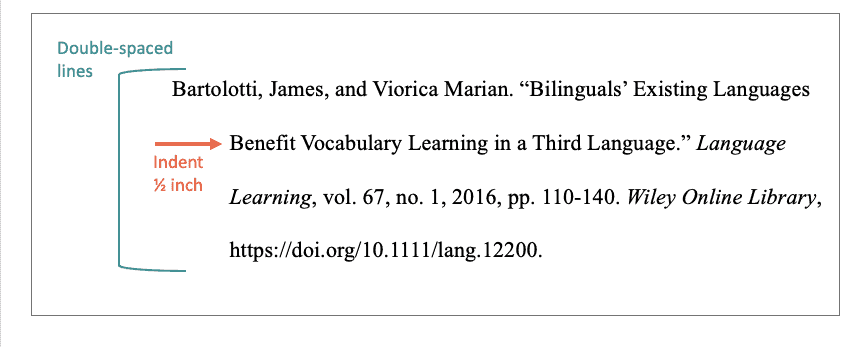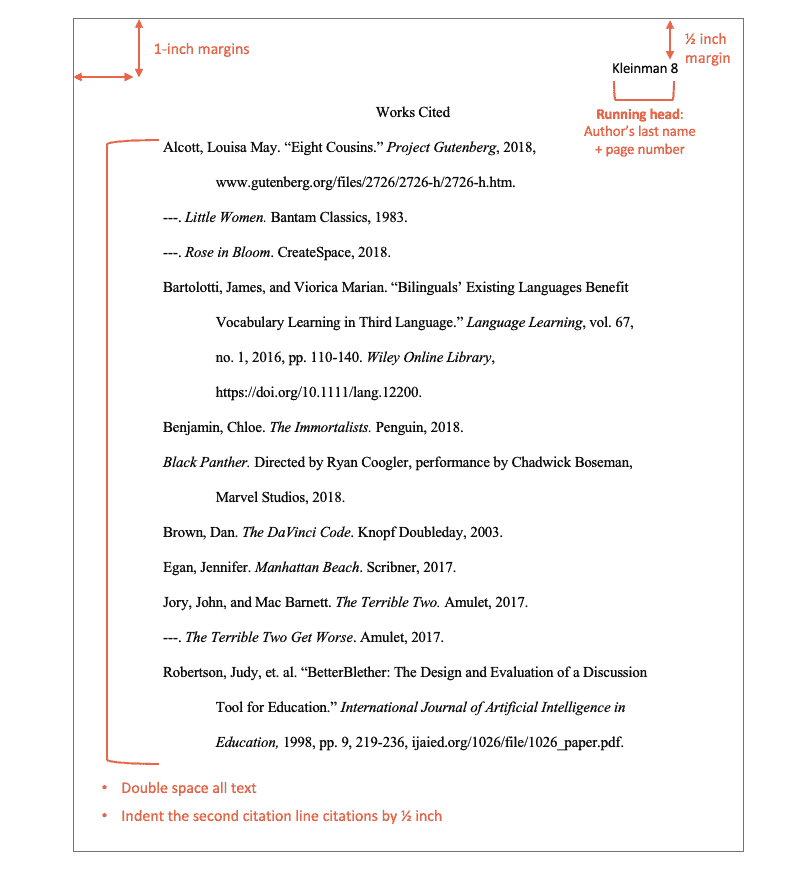- Your essay should have a header on every page that includes your last name and the page number.
- The last name/page number header should be on the top right of each page with a ½ inch margin from the top of the page.

- Only center the Works Cited title; all citations should be left-justified.
- Double-space citations.
- Do not add an additional space between citations.
- After the first line, use a hanging indent of ½ inch on all additional lines of a citation. The hanging indent should look like this:

- List citations alphabetically by the first word of the citation.
- Typically, this is the author’s last name, but sometimes it could be the title of the source if the author’s name is not available.

If you have a Works Consulted or Additional Resources page after your Works Cited page, format it in the same way, but with the title of Works Consulted or Additional Resources instead of Works Cited. Alternatively, your instructor may require a bibliography. If this is the case, all your sources, whether they are cited in your paper are not, are listed on the same page.
MLA citation guidelines
These are the rules you need to follow to create citations for an MLA bibliography. This section contains information on how to correctly use author names, punctuation, capitalization, fonts, page numbers, DOIs, and URLS in the citations on your MLA bibliography.
Author names
After the title Works Cited, the last name of the author of a source should be the first thing to appear on your page.
List the author’s last name followed by a comma, then the first name followed by the middle name or middle initial if applicable, without a comma separating the first and middle names. Add a period after the name.
Examples:
Smith, Alexander McCall.
- Do not include titles such as Dr., Mrs., etc. or professional qualifications such as PhD, M.S., etc. with author names.
- Include suffixes such as Jr. or III after the author’s first name. Separate the first name and the suffix by a comma unless the suffix is a numeral. For example, to cite an author named John Smith, Jr., you would type Smith, John, Jr.
Sources with two authors
For a source with two authors, list the author names in your citation in the order they appear on the source, not alphabetically.
Type the last name of the first author listed on the source followed by a comma, then the first author’s first name followed by a comma. Then type the word “and” then list the second author’s first name and last name in the standard order. Follow the second name with a period.
Include middle names or initials and suffixes when applicable according to the guidelines for one author as listed above.
Structure:
1st Author’s Last Name, First Name, and 2nd Author’s First Name Last Name.
Examples:
Lutz, Lisa, and David Hayward.
Clark, Mary Higgins, and Alafair Burke.
Sources with three or more authors
For a source with three or more authors, only type the last and first name of the first author listed in the source, followed by a comma and the phrase et al., which is Latin for “and others.” Be sure to always place a period after the al in et al. but never after the et.
Structure:
1st Author’s Last Name, First Name, et al.
Examples:
Charaipotra, Sona, et al.
Williams, Beatriz, et al. All the Ways We Said Goodbye. HarperLuxe, 2020.
Organizations and corporations as authors
For sources with organizations or corporations listed as the author, type the name of the corporation in place of an author’s name. If the organization begins with an article like a, an, or the, it should be excluded in the Works Cited entry.
Example:
Modern Language Association of America. MLA Handbook. 2016.
*Note: If the organization is listed as both the author and the publisher, begin the citation with the title and include the organization’s name within the publisher field instead.
For a source with no author listed, simply omit the author’s name and begin the citation with the title of the source. Use the first letter of the title when considering alphabetical order in your MLA bibliography.
Capitalization
Use MLA title case when citing titles of sources.
- Nouns, pronouns, verbs, adverbs, adjectives, and subordinating conjunctions should be capitalized.
- Articles, prepositions, and coordinating conjunctions should not be capitalized.
Font formatting
- Italicize the titles of larger works such as magazines and books. Also, italicize database and website names.
- Instead of italicization, use quotation marks around titles of shorter works such as poems, short stories, and articles.
- End all bibliography citations with a period.
Page numbers
Include page numbers in your full citations whenever possible. This helps the reader find the information you cited more quickly than if you just cited the entire source and lends more credibility to your argument. If you cite different pages from the same source within your paper, you should cite the entire source on your MLA bibliography instead of listing all of the page numbers you used.
When including page numbers in a citation, use the abbreviation p. to cite one page and the abbreviation pp. to cite multiple pages with a hyphen between the page numbers.
Example:
p. 25 or pp. 16-37
When citing page numbers in MLA, omit the first set of repeated digits.
Example:
pp. 365-69, not pp. 365-369
DOIs and URLs
A Digital Object Identifier (DOI) is used to locate and identify an online source. While URLs may change or web pages might be edited or updated, a DOI is permanent and therefore more useful in a source citation.
- Use a DOI (digital object identifier) whenever possible. Otherwise use a permalink or URL.
- DOIs should be formatted with “https://doi.org/” before the DOI number.
- Do not include “http://” or “https://” in your URLs.
- As either one will be the last part of your citation, place a period after the DOI or URL. (Note that this period is not part of the DOI or URL.)
Example:
Butarbutar, R, et al. “Analyzing of Puzzle Local Culture-Based in Teaching English for Young Learners.” IOP Conference Series: Earth and Environmental Science, vol. 343, 2019, https://doi.org/10.1088/1755-1315/343/1/012208.
Accessed dates
Since the previous 8th edition of the MLA Handbook was published, you do NOT need to list an accessed date for a stable source (e.g., online newspaper article, journal article, photograph, etc.). However, including an access date is good to include when a source does not have a publishing date, and some instructors will request that accessed dates be included for all sources.
If you do include an access date, here’s how to format it:
- Place it at the end of the citation without “http://” or “https://”.
- Write “Accessed” first, followed by the date accessed.
- The date accessed should be formatted as Day Month (abbreviated) Year.
Example:
Butarbutar, R, et al. “IOPscience.” IOP Conference Series: Earth and Environmental Science, IOP Publishing, 1 Oct. 2019, iopscience.iop.org/article/10.1088/1755-1315/343/1/012208/meta. Accessed 8 Oct. 2020.
Note: If you choose to list an accessed date after a DOI, the accessed date part of the citation will follow the period after the DOI and will end with a period at the end of the citation
Example:
Butarbutar, R, et al. “Analyzing of Puzzle Local Culture-Based in Teaching English for Young Learners.” IOP Conference Series: Earth and Environmental Science, vol. 343, 2019, https://doi.org/10.1088/1755-1315/343/1/012208. Accessed 8 Oct. 2020.
MLA 8 th edition vs MLA 9 th edition
The 9 th edition of the MLA handbook re-introduces guidelines regarding paper formatting (which were not present in the 8 th edition). The guidance in the 9 th addition is consistent with the guidance in previous editions and expands on the formatting of tables, figures/illustrations, and lists. The 9 th edition also offers new guidance in areas like annotated bibliographies, inclusive language, and footnotes/endnotes.
Many of the differences between the 8 th edition and 9 th edition have to do with the formatting of the core elements in reference list entries. Some of the main changes include:
MLA 8 MLA 9 DOI format: doi:10.1353/aeh.2021.0012 DOI format: https://doi.org/10.1353/aeh.2021.0012 Seasons for publications capitalized: Winter 2021 Seasons for publications not capitalized: winter 2021 Publisher format: Use “U” for University and “P” for Press in publisher names (i.e., MIT P) Publisher format: Use “U” for University and “P” for Press in publisher names unless the word “university” is not present (in any language) (e.g., MIT Press) Organization authors: full name should be used Organization authors: if the organization has a long name, it should be shortened in the in-text citation (i.e., American Society for the Prevention of Cruelty to Animals = American Society) Social media: author’s username should be used Social media: author’s real name or account name (if available) should be used URLs: include full URL URLs: Shorten URL if longer than 3 lines (include at least the host) and always eliminate the https:// except in DOIs Pseudonyms: include in parentheses Pseudonyms: include in square brackets Written by Grace Turney, freelance writer and artist. Grace is a former librarian and has a Master’s degree in Library Science and Information Technology.
MLA Formatting Guide
MLA Formatting
- Abstract
- Annotated Bibliography
- Bibliography
- Block Quotes
- Containers
- et al Usage
- Footnotes
- In-text Citations
- Paraphrasing
- Page Numbers
- Sample Paper
- Title Page
- Works Cited
- MLA 8 Updates
- MLA 9 Updates
- View MLA Guide